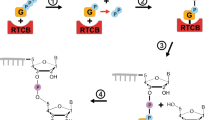Abstract
Dxl6 is a member of the Drosophila melanogaster SR protein family, a group of nuclear proteins that are both essential splicing factors and specific splicing regulators. To get more insight of Dx16 function, we generated the monoclonal antibody against Dx16 and determined its expression pattern and subcellular location. It is mainly expressed in the nucleus of CNS in Drosophila embryos. In order to investigate the RNA-binding specificity of Dxl6, Dxl6-binding RNAs were identified by SELEX screen by using recombinant Dxl6 N-terminus protein as the target. These RNAs contained a consensus motif. Some pre-mRNAs from the corresponding genes showed splicing defects in the Dxl6-P-element insertional mutant fly. These results indicate that Dxl6 has unique functions in the removal of some introns during development.




Similar content being viewed by others
References
Mangs AH, Speirs HJ, Goy C, Adams DJ, Markus MA, Morris BJ (2006) XE7: A novel splicing factor that interacts with ASF/SF2 and ZNF265. Nucleic Acids Res 34(17):4976–4986
Hastings ML, Krainer AR (2001) Pre-mRNA splicing in the new millennium. Curr Opin Cell Biol 13(3):302–309
Ring HZ, Lis JT (1994) The SR protein B52/SRp55 is essential for Drosophila development. Mol Cell Biol 14(11):7499–7506
Wang J, Takagaki Y, Manley JL (1996) Targeted disruption of an essential vertebrate gene: ASF/SF2 is required for cell viability. Genes Dev 10(20):2588–2599
Longman D, Johnstone IL, Caceres JF (2000) Functional characterization of SR and SR-related genes in Caenorhabditis elegans. EMBO J 19(7):1625–1637
Jumaa H, Wei G, Nielsen PJ (1999) Blastocyst formation is blocked in mouse embryos lacking the splicing factor SRp20. Curr Biol 9(16):899–902
Blencowe BJ (2000) Exonic splicing enhancers: Mechanism of action, diversity and role in human genetic diseases. Trends Biochem Sci 25(3):106–110
Xiao SH, Manley JL (1997) Phosphorylation of the ASF/SF2 RS domain affects both protein–protein and protein–RNA interactions and is necessary for splicing. Genes Dev 11(3):334–344
Vorbruggen G, Onel S, Jackle H (2000) Localized expression of the Drosophila gene Dxl6, a novel member of the serine/arginine rich (SR) family of splicing factors. Mech Dev 90(2):309–12
Shi H, Hoffman BE, Lis JT (1997) A specific RNA hairpin loop structure binds the RNA recognition motifs of the Drosophila SR protein B52. Mol Cell Biol 17(5):2649–2657
Hoffman BE, Lis JT (2000) Pre-mRNA splicing by the essential Drosophila protein B52: Tissue and target specificity. Mol Cell Biol 20(1):181–186
Rasheva VI, Knight D, Bozko P, Marsh K, Frolov MV (2006) Specific role of the SR protein splicing factor B52 in cell cycle control in Drosophila. Mol Cell Biol 26(9):3468–3477
Kumar S, Lopez AJ (2005) Negative feedback regulation among SR splicing factors encoded by Rbp1 and Rbp1-like in Drosophila. EMBO J 24(14):2646–2655
Du C, McGuffin ME, Dauwalder B, Rabinow L, Mottox W (1998) Protein phosphorylation plays an essential role in the regulation of alternative splicing and sex determination in Drosophila. Mol Cell 2(6):741–750
Yuan B, Farkas R, Lee K, Rabinow L (1994) The Doa locus encodes a member of a new protein kinase family and is essential for eye and embryonic development in Drosophila melanogaster. Gene Dev 8(10):1160–1173
Johnson KG, Ghose A, Epstein E, Lincecum J, O’Connor MB, Van Vactor D (2004) Axonal heparan sulfate proteoglycans regulate the distribution and efficiency of the repellent slit during midline axon guidance. Curr Biol 14(6):499–504
Johnson KG, Tenney AP, Ghose A, Duckworth AM, Higashi ME, Oarfitt K, Marcu O, Heslip TR, Marsh JL, Schwarz TL, Flanagan JG, Van Vactor D (2006) The HSPGs syndecan and dallylike bind the receptor phosphatase LAR and exert distinct effects on synaptic development. Neuron 49(4):517–531
Babu K, Bahri S, Alphey L, Chia W (2005) Bifocal and PP1 interaction regulates targeting of the R-cell growth cone in Drosophila. Dev Biol 288(2):372–386
Acknowledgement
We thank Dr. G. Boulianne (University of Toronto) for providing us with the flies used in this work. This study was supported by NSFC (30270309) from P.R.China.
Author information
Authors and Affiliations
Corresponding author
Rights and permissions
About this article
Cite this article
Yuan, L., Zhou, J., Wan, Y. et al. Identification of RNA binding sequences of Drosophila SR protein DX16. Mol Cell Biochem 302, 119–124 (2007). https://doi.org/10.1007/s11010-007-9433-6
Received:
Accepted:
Published:
Issue Date:
DOI: https://doi.org/10.1007/s11010-007-9433-6




